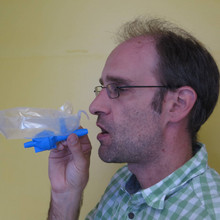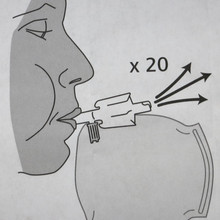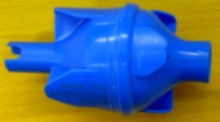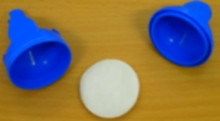Atemgasanalyse


Nachweis von Dopingsubstanzen in der Atemluft
Erstmalig wurde eine Methode zum Nachweis von Dopingsubstanzen in der Atemluft entwickelt.
Thevis M, Krug O, Geyer H, Schänzer W. Expanding analytical options in sports drug testing: Mass spectrometric detection of prohibited substances in exhaled breath. Rapid Commun Mass Spectrom. 2017 Aug 15;31(15):1290-1296.
download des Abstracts
download gesamter Artikel
Die Publikation fasst Ergebnisse eines Pilotprojektes zusammen und zeigt für die untersuchten Dopingsubstanzen die gute Nachweismöglichkeit dieser Substanzen in der Atemluft auf.
s.a. Beitrag im Deutschlandfunk vom 17.4.2017
Die Atemgasanalyse ist aufgrund der beachtlichen Fortschritte der letzten Jahre in der Analysetechnik (wie GC-MS, GC-MS-MS und LC-MS-MS) und der damit verbundenen verbesserten Nachweisempfindlichkeit nun auch für einen Einsatz in der Dopinganalytik prinzipiell möglich.
Die Abnahme von Atemgasproben ist im Gegensatz zu der Abnahme von Blutproben nicht-invasiv und kann beliebig oft wiederholt werden.


Praktisches Vorgehen bei der Atemgasanalyse
Mit Hilfe der Atemgaskartusche (Abb.3) wird eine Atemgasprobe abgegeben, dazu atmet der Proband etwa 20 mal, bis der Atemvolumen-Kontrollbeutel gefüllt ist, durch die Kartusche (Abb. 1 und 2). In der Kartusche befindet sich eine aus Kunstfaser bestehende Membran, auf der die abgeatmeten Zielanalyten zurückgehalten werden (Abb. 4). Die Analyten werden im Labor wieder aus der Membran extrahiert und mit unterschiedlichen analytischen Techniken bestimmt.
1.August 2017
Weitere Publikationen
Garzinsky AM, Thomas A, Krug O, Thevis M. Probing for the presence of doping agents in exhaled breath using chromatographic/mass spectrometric approaches. Rapid Commun Mass Spectrom. 2021 Jan 15;35(1):e8939. doi: 10.1002/rcm.8939. PMID: 32881194.
Abstract
Rationale: Continuously refining and advancing the strategies and methods employed in sports drug testing is critical for efficient doping controls. Besides improving and expanding the spectrum of target analytes, alternative test matrices have warranted in‐depth evaluation as they commonly allow for minimal‐/non‐invasive and non‐intrusive sample collection. In this study, the potential of exhaled breath (EB) as doping control specimen was assessed.
Methods: EB collection devices employing a non‐woven electret‐based air filter unit were used to generate test specimens, simulating a potential future application in doping controls. A multi‐analyte sports drug testing approach configured for a subset of 12 model compounds that represent specific classes of substances prohibited in sports (anabolic agents, hormone and metabolic modulators, stimulants, and beta‐blockers) was established using unispray liquid chromatography/tandem mass spectrometry (LC/MS/MS) and applied to spiked and elimination study EB samples. The test method was characterized concerning specificity, assay imprecision, and limits of detection.
Results: The EB collection device allowed for retaining and extracting all selected model compounds from the EB aerosol. Following elution and concentration, LC/MS/MS analysis enabled detection limits between 5 and 100 pg/filter and imprecisions ranging from 3% to 20% for the 12 selected model compounds. By means of EB samples from patients and participants of administration studies, the elimination of relevant compounds and, thus, their traceability in EB for doping control purposes, was investigated. Besides stimulants such as methylhexaneamine and pseudoephedrine, also the anabolic‐androgenic steroid dehydrochloromethyltestosterone, the metabolic modulator meldonium, and the beta‐blocker bisoprolol was detected in exhaled breath.
Conclusions: The EB aerosol has provided a promising proof‐of‐concept suggesting the expansion of this testing strategy as a complement to currently utilized sports drug testing programs.